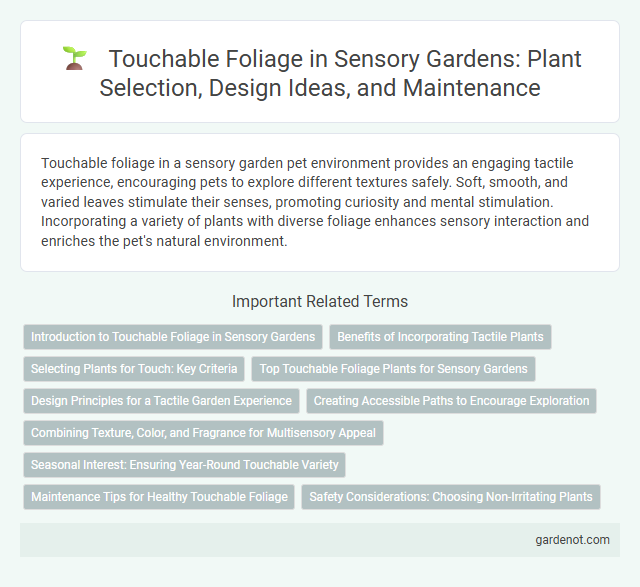Touchable foliage in a sensory garden pet environment provides an engaging tactile experience, encouraging pets to explore different textures safely. Soft, smooth, and varied leaves stimulate their senses, promoting curiosity and mental stimulation. Incorporating a variety of plants with diverse foliage enhances sensory interaction and enriches the pet's natural environment.
Introduction to Touchable Foliage in Sensory Gardens
Touchable foliage in sensory gardens offers a diverse range of textures, colors, and shapes that engage the sense of touch, enhancing sensory stimulation and connection to nature. Plants such as lamb's ear, with its soft, velvety leaves, and ornamental grasses provide unique tactile experiences that cater to individuals of all ages and abilities. Integrating touchable foliage supports therapeutic benefits, cognitive development, and emotional well-being within sensory garden environments.
Benefits of Incorporating Tactile Plants
Touchable foliage enhances sensory gardens by providing varied textures that stimulate touch and improve sensory processing skills. Incorporating tactile plants such as lamb's ear, ornamental grasses, and lamb's tongue encourages exploration and mindfulness, benefiting individuals with sensory processing disorders or cognitive impairments. These plants also promote emotional well-being by offering calming, grounding experiences through direct physical interaction.
Selecting Plants for Touch: Key Criteria
Selecting plants for a sensory garden's touchable foliage involves prioritizing textures that vary from soft, fuzzy leaves like lamb's ear to smooth, waxy succulents such as jade plants. Key criteria include the plant's tactile appeal, durability to frequent handling, and non-toxicity for safe interaction by all age groups. Ensuring a diverse range of leaf shapes, thicknesses, and surface textures heightens sensory engagement and enhances the therapeutic benefits of the garden.
Top Touchable Foliage Plants for Sensory Gardens
Top touchable foliage plants for sensory gardens include lamb's ear (Stachys byzantina), known for its soft, velvety leaves that provide a soothing tactile experience. Silverdust (Dusty Miller) features silvery, textured foliage that contrasts beautifully with other plant textures, enhancing sensory engagement. Other excellent choices are herbs like rosemary and thyme, which offer fragrant, textured leaves ideal for touch and scent stimulation.
Design Principles for a Tactile Garden Experience
Touchable foliage in a sensory garden enhances tactile stimulation by incorporating diverse leaf textures such as velvety lamb's ear, rough sage, and smooth hosta. Design principles emphasize varying shapes, sizes, and surfaces to engage different touch receptors, promoting sensory exploration and cognitive development. Strategic plant placement at accessible heights ensures ease of interaction while maintaining safety and durability in all weather conditions.
Creating Accessible Paths to Encourage Exploration
Creating accessible paths in a sensory garden with touchable foliage involves using smooth, wide surfaces such as compacted gravel or rubberized mats to accommodate wheelchairs and strollers. Strategic placement of low-growing, textured plants like lamb's ear, ornamental grasses, and herbs along the path edges invites tactile engagement and sensory discovery. Consistent signage with braille and raised lettering ensures inclusive access, encouraging visitors of all abilities to explore and connect with the garden environment.
Combining Texture, Color, and Fragrance for Multisensory Appeal
Touchable foliage in sensory gardens combines diverse textures, vibrant colors, and aromatic scents to engage multiple senses simultaneously. Plants like lamb's ear provide soft, velvety leaves, while herbs such as lavender contribute fragrance and visual contrast with their purple flowers. Integrating tactile, visual, and olfactory elements enhances the overall sensory experience, promoting relaxation and sensory stimulation.
Seasonal Interest: Ensuring Year-Round Touchable Variety
In a sensory garden, selecting touchable foliage with diverse textures and colors guarantees seasonal interest and year-round engagement. Incorporating evergreens like boxwood alongside deciduous plants such as lamb's ear provides a dynamic sensory experience through changing seasons. Strategically combining soft, fuzzy leaves with rough, textured ones enhances tactile exploration regardless of the time of year.
Maintenance Tips for Healthy Touchable Foliage
Touchable foliage in sensory gardens requires regular pruning to prevent overgrowth and maintain tactile appeal. Consistent watering and mulching help sustain leaf texture and vibrancy, ensuring an engaging sensory experience. Inspecting for pests and diseases early supports healthy foliage and prolongs plant lifespan in interactive garden spaces.
Safety Considerations: Choosing Non-Irritating Plants
Selecting non-irritating plants such as lamb's ear (Stachys byzantina), rosemary (Rosmarinus officinalis), and scented geraniums (Pelargonium spp.) ensures safe interaction within a sensory garden. Avoiding species with thorns, sap, or allergenic properties reduces the risk of skin irritation or allergic reactions for visitors of all ages. Prioritizing hypoallergenic and soft-textured foliage enhances a tactile experience while maintaining the garden's safety standards.
Touchable foliage Infographic

 gardenot.com
gardenot.com